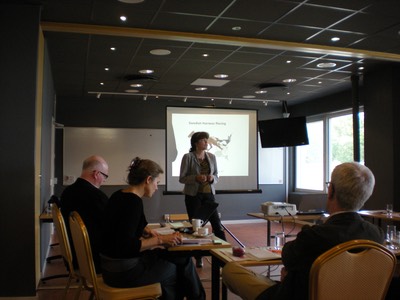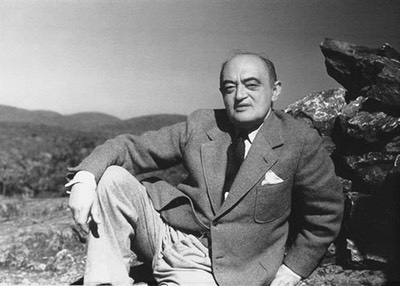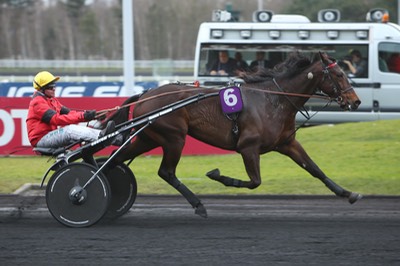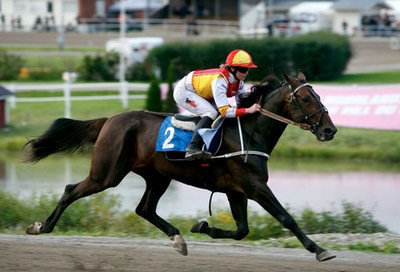A guest commentary by Prof. Ulf Lindström
European trotting* is a struggling industry. If there's a silver lining to this picture, notably the breaking of world-records as proof of a thriving sport,** the breeding statistics project troubled times. Until the number of new-born trotters across Europe turns northward the industry cannot be content with its position and prospects. As breeding declines upsets by trotters from second-tier nations, like Brad de Veluwe, Brioni, Virgill Boko, Trebol and Papagayo E., become too few and far between. French, Italian and Swedish celebrities like Bold Eagle, Varenne and Maharajah testify to the public appeal of poster horses.
Four years ago Solvalla racetrack and CEO Tore Fyrand hosted a roundtable on cross-disciplinary research on European trotting. I had the pleasure of coordinating the meeting. It brought a dozen scholars and writers to Stockholm, from the Nordic countries, Austria, France, Germany and Italy. Talks by promotor Klaus Koch, ST Head of Breeding Christina Olsson, VMD Rikke Buhl, Professor Bertrand Langlois and Per Johnsson of the Bloodbank added hard facts for informative exchange of input among the participants. The outcome of the roundtable is one immediate, an inventory of research on trotting available via www.breedingtrotters.com, *** and to have made our equine discipline known among the established networks of scholars who focus on the saddle sports and companionship horsekeeping.
What follows is my own reflection on the status of European trotting, the equine economics. All too often scholars with a heart for horses seem to live in a never-never land of Arabian sheikhs, American heiresses and British gentry. A Viennese approach is more appropriate: creative destruction (Kreative Zerstörung). Coined by economist and horseman Joseph Schumpeter (1883-1950), the term may be inverted too. Destructive creativity (Bewältigung durch Kreativität) as a response to challenge may spell unintended consequences to European trotting.
At the end of the day, 24/365, trotting is about horses and the economy - inseparably so. Horses are not kept for purposes other than pleasure and entertainment. Casual patrons of our business expect to be catered to, like fine dining and courtesy shown by track staff. Still, it's about horses; for the analysis of what makes for lasting and deeper commitment to the sport among the public at large one must always return to the differentia specifica, the animal. For the food? Restaurateurs and chefs seldom fight over the franchise and prestige of serving the gourmets of the racetrack.
A decent fare at a decent price and, for the track's commission on the simulcast, ten percent lower takeout on betting compared to the off-track rate would bring more people to experience the ambiance of the place. As a reward program to loyal customers, those who embody the raison d'être of the hippodrome, subsidizing visitors Las Vegas-style makes sense. Fairs and concerts at the tracks are extras only, for the revenue.
Success requires sacrifice; dumping old modes of production, distribution, and marketing. In the process of change people too will get hurt, their beliefs, commitments and ultimately endanger their paychecks. In a predicament like this corporations are liable to overreact - succumb to investment fetishism, destructive creativity - in a way that reminds of pulling oneself up by the bootstraps.
European trotting needs a brutal no-holds-barred response to the question "what is required to pull off a race"? The inspiration for this is another mass-market service, the low-cost carrier for air transport: "what is required to make the aircraft take off"? Obviously, the horse and the aircraft are indispensable. But from there down to the least crucial factor cum manpower, the logistics, truly there must be points in between that are expendable?
Not imminently. In a "dance around the not-so-golden foal" in the hope of a growing market (ownership and handle at the tote) the sport is prey to a communicative agenda with corresponding staffing that the base - breeders, horseowners and gamblers - cannot sustain. Agendas lead lives of their own, spawning memos on additional positions accompanied by job descriptions inaccessible to most everyone in the industry, positions inexcusable to question whenever the intention is to improve communication, the silver bullet of management jargon.
Of course it's important to
have skilled manpower hired for the key functions of the industry, for
the welfare of the animal, the maintenace of the facilities, and the
hospitality function. As for consultants for software upgrades, track
amenities, legal compliance, EHS-management, community outreach and the
black hole of contingency planning, they are of more than abundant
supply and need not be on retainers. Consultants - past and future - may
perhaps have the decency to put in a few pro bono hours as indemnity
for years of reports of clichés - "think outside the box" - and inflated
invoices? Community outreach is essentially a spontaneous activity;
ever widening circles of people "symphatetic to the trots" are the most
effective as bona fide ambassadors of the sport. Passionate fans, like
all zealots, meet with scepticism at best.
While
naturally open for new assignments to one's own job, officials of the
administration of the industry hint to entirely new positions for
control regimes, clerical tasks, salaried community outreach, etc.
Again, the airline industry: flag-carriers in particular proved it was
feasible to cut positions galore, scrap frills, freeze pay, offload
auxilliary support and redirect customers to self-service.
A benchmark for transaction costs in the horse industry is indeed the self-service mixed sale on the Internet. Buyers, saving hours on the road, in the air and hotels, accessing information on the horses from any location, split the sellers' bills for nomination fees and the certificates issued by local veterinarians - and no charge at all for consignor, fancy halter, stall rent, agent's commission and buybacks! In contrast, the select yearling sales - a treat to attend, to see and be seen across species, inalienable rite to recruit the young and routine to confirm the fidelity to trotting among fellow aficionados - draw transaction costs of whooping proportions relative to the horseflesh exchanged. Worth the hoopla? Possibly, utility calculus pending.
Benchmarking - across procedures, across tracks, across jurisdictions - is worthwhile only if observations are practicable right away and at risk of failure. Benchmarking elaborated on by hired consultants mean anticipated reports. Raising the "ifs-and-buts" among the addressees the reports tend to get filed away as another tribute to bureaucratic inertia.
Racedays and racecards, stakes or overnighters, stallion grading or free breeding, simulcasts or blackouts set the parameters of the logistics of trotting. All else is embellishment and detail, of which plenty enough are visited by the boogeyman.
Regular racedays overshadowed by racing "events," the fine-tuning of the season calendar across Europe is welcome. The flipside, national meets that get ever less latitude for improvising, is tolerable if it upends stifling domestic consensus.
All-European stakes, net-based nominations at moderate fees and mimimum banking hassle, are still rare compared to the lavish North American menu. Breeders Course, E3, Europe Future Cup are cases in point (while the first RUS stake is still to be announced, cf., below). To economize on transportation - and to aid the old heartland of the sport until it regains momentum - Central Europe would be the preferred region for Euro-stakes finals. Awarded tracks that can top up with attractive undercards, this would mean Oktoberfest mit Prädikat! A turnout of 3,000 spectators at, e.g., Gelsenkirchen generates a collective feel-good response of higher value and inspiriation to the half-dozen tracks in the region than what the corresponding attendance at Solvalla and Vincennes produces. Winter is anyway synonymous with Paris, France. Summers make sense for Nordic campaigning, which would leave the Mediterranean tracks with the Spring schedule.
For overnighters, more claiming races also offer opportunities to offload older and sound horses to first-time owners, not least among those with an open mind to racing their horses under saddle, RUS. North-American conformity of racing format is to be avoided by Europe. Full fields for longer distances, 36/3600 security permitting, may also check in-breeding. Stallion grading, if deemed vital, is best be left to the Swedish ST until otherwise called for, not be duplicated country by country for stallions to serve across Europe.
Like rock concerts shutting out the media, now and then a few racecards of unorthodox conditions may be reserved for on-site spectators only, nights subsequently to become the stuff of legend by the spinning of yarns of what actually happened. If that sounds flippant, what about the simulcasts that keep people away from the tracks? Irreversible feature, no doubt, unlike the policy of the tracks to allow webcasters transmission rights for practically nothing. The overcrowding of the simulcast productions is evidence of money waived by the host track. One webcaster seats three anchors in the studio. The reason they are not four is the screen format is optimal for three. Surely, one anchor only and less noise ahead of post-time would not make the viewers despair, just as passengers are not alarmed by not having three pilots in the cockpit and endless security announcements in the cabin? Self-nominated, handicappers are to be remunerated and weeded out by the punters.
Painful cuts and risky ventures are the responsibilty of the executives, that's what leadership is about, not to pass the bucket to consultants. "Detail" bites, it's time to move the horseowners, breeders and trainers and grooms up the breadline.
A
commendable habit of Schumpeter was to annoy the university top brass
and be gentle with his students.# Thus, the first target in the
cross-hairs is the European federation of trotting, the U.E.T. A French
vaudeville with a Swedish sideshow - not a European federation - it
should be terminated. Which European federation in the field of sports,
culture, science and business would accept to be steamrolled again and
again by one single member? (Save perhaps for the cricket federation
kowtowing to the English?) In the meantime, and understandably, thrifty
track officials are well advised to initiate cross-national projects
off-limits to U.E.T. interference.
Citing the nonsense of a unique breed - like Bold Eagle (Workaholic 3+4) - the French SCF is still allowed to bar the entry of non-French breds in 80 percent of their races. French-bred is a condition for entering races in other countries sponsored by the PMU tote. Import of foreign-born broodmares, however "French" in pedigree, is banned. Tit-for-tat(?), the Swedish response is to up the breeding premiums on purse money earned by Swedish bred trotters, in the process pulling out the rug from under stud operations in neighboring countries.
The sessions of the U.E.T., bogged down by institutional dysfunction, are stalling the progress of a viable European sport. Furthermore, at times European officials seem more occupied by American state-rights in governing harness racing than in getting their own act together. A coalition of the willing from North America, Europe and Oceania would provoke the replacement of the U.E.T. with an equitable European forum. Copying the European Equestrian Federation, EEF, is an option too. Protectionism is never the answer, as the delegates to the World Trotting Conference next year in Canada know only too well and will reiterate in 2019.
Sporting jodhpurs and riding helmet when
arriving late to faculty meetings after his morning rides, Schumpeter on
and off toyed with the idea of becoming a horseman. At 5'8" he'd been a
trainer, perhaps of RUS horses too (Racing Under Saddle, or Monté.)
That brings us to the creative-only section of this reflection on
European trotting: a massive push for RUS.
• RUS in general harmonizes with the times of change.
• Horse people form a "cluster" of inter-disciplinary dialogue and mobility.
•
Policies to upgrade RUS - say, every fourth race for purses equal to
regular sulky races, a couple of stakes per season, of which one
European - may be implemented with care and at sensible transaction
costs.
For tracks on life-support, already too many, a raceday every two weeks featuring two or three RUS races each instead of one raceday a month with solid sulky racecards, the prognosis is somewhat brighter. The twelve-racedays-a-year track is not worth its salt, easily relegated to fair status.
True, horse ownership in full or part cost more than most pastimes. But you cannot cultivate the bonds, let alone "talk" to a RV, motorbike and speedboat, like you can relate to a horse. Conveniently stabled just outside the city, suburbanization and urban sprawl mean more and more people of above average income get to admire the horse "on location" for its beauty, stoicism and enigma. Quarters, showjumpers, trotters, here's where their owners and connections of tomorrow live. For trotters the new kind of owners are to fill in for the typical owners of the past, the non-descript small businessmen of the inner-city who used to keep a cash-flow on the side for, well, "incidentials" but sold out the family companies to the big chains of the shopping malls. (Grateful as we are, but forget about the big-time owners, celebrity owners and high-rollers. They provide the horseflesh for the blueblooded matings and trotting fests; the supply of tote-fodder and handle to uphold the infrastructure of the sport must rely on the unnamed many.)
"You'll never walk alone." People find and stay with their favorite sports in the company of their peers. Company used to be a male thing until sportsbars invited the multitude for beer and brawls under a cacophony of screens. Now company is a women thing, middle-class girls and their mothers who know how to behave, to ask for opportunities and are set to make the most of the options. The gender balance in European trotting is dismal reading, but on second thought an enormous potential to lift the industry and sport to a comeback on the scale of biathlon. (Who, twenty-five years ago, would have thought a sport of East European border police, Alpenjäger and average skiers from the Nordic countries could survive?)
The road to RUS origintates at the
ubiquitous riding schools. However biased against trotting, the schools
should be invited to become "amicable partners" of their nearest
racetrack/trotting clubs, the pupils and guardians issued free passes to
the track and its stable area. On select racedays the track's RUS
section invites the pupils of the riding schools and their parents to
RUS clinics and offers them - dad too - the opportunity to mount a kind
horse. In the process, the visitors are exposed to the excellent
horsemanship typical of the trotting sport (compared to that of riding
schools and arguably thoroughbred tracks too).
Geldings of untapped RUS talent can be bought for less than sulky horses, so the next step to RUS is shorter than the first: the distance to the parents' pocketbooks and onwards to their hope of some purse money in return. Once the families and connections are into RUS they soon realize that, at step three, the sulky is not more of an alien contraption to horse racing than obstacles to showjumping.
Extrapolating, how far off is the day when trainers realize that, after the hype about bikes and barefoot balance, the next (and coincidentally fourth) step in the quest for faster performance by the horses is the weight of the jockey-driver? Ceteris paribus, as Schumpeter would have told the trainers and owners, the difference of 20 kilograms of excess bagage in the sulky is what's counted at the wire.
Economists and
investors alike froth at numbers. European trotting would be served by
the ultimate price-earnings (p/e) ratio: the number of overhead staff
relative to dual-licenced jockey-drivers and their earnings.
Ulf Lindström
* Except for Great Britain, pacers do not officially race in Europe, so 'harness racing' is trotting.
** Continuously updated, http://www.travronden.se/world-records/en
*** http://www.breedingtrotters.com/content-2/international/euret-live.html
#
Students of trotting, irrespective of age and station, are welcome to
mail me in their search of sources and for feedback on topics for term
papers and theses, euret@live.com
On Schumpeter, T.K. McCraw, Prophet of Innovation (2007).
2016_08



